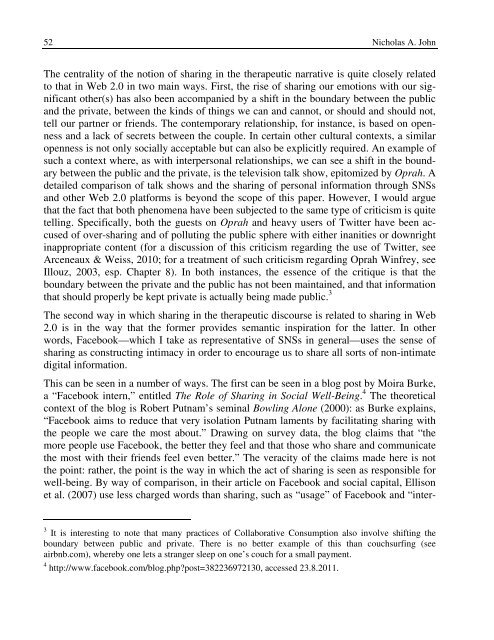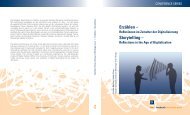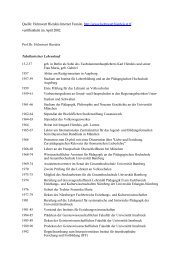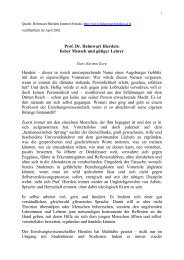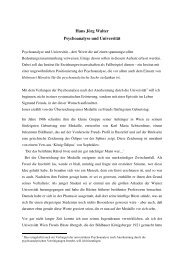Download pdf - Universität Innsbruck
Download pdf - Universität Innsbruck
Download pdf - Universität Innsbruck
Erfolgreiche ePaper selbst erstellen
Machen Sie aus Ihren PDF Publikationen ein blätterbares Flipbook mit unserer einzigartigen Google optimierten e-Paper Software.
52 Nicholas A. John<br />
The centrality of the notion of sharing in the therapeutic narrative is quite closely related<br />
to that in Web 2.0 in two main ways. First, the rise of sharing our emotions with our significant<br />
other(s) has also been accompanied by a shift in the boundary between the public<br />
and the private, between the kinds of things we can and cannot, or should and should not,<br />
tell our partner or friends. The contemporary relationship, for instance, is based on openness<br />
and a lack of secrets between the couple. In certain other cultural contexts, a similar<br />
openness is not only socially acceptable but can also be explicitly required. An example of<br />
such a context where, as with interpersonal relationships, we can see a shift in the boundary<br />
between the public and the private, is the television talk show, epitomized by Oprah. A<br />
detailed comparison of talk shows and the sharing of personal information through SNSs<br />
and other Web 2.0 platforms is beyond the scope of this paper. However, I would argue<br />
that the fact that both phenomena have been subjected to the same type of criticism is quite<br />
telling. Specifically, both the guests on Oprah and heavy users of Twitter have been accused<br />
of over-sharing and of polluting the public sphere with either inanities or downright<br />
inappropriate content (for a discussion of this criticism regarding the use of Twitter, see<br />
Arceneaux & Weiss, 2010; for a treatment of such criticism regarding Oprah Winfrey, see<br />
Illouz, 2003, esp. Chapter 8). In both instances, the essence of the critique is that the<br />
boundary between the private and the public has not been maintained, and that information<br />
that should properly be kept private is actually being made public. 3<br />
The second way in which sharing in the therapeutic discourse is related to sharing in Web<br />
2.0 is in the way that the former provides semantic inspiration for the latter. In other<br />
words, Facebook—which I take as representative of SNSs in general—uses the sense of<br />
sharing as constructing intimacy in order to encourage us to share all sorts of non-intimate<br />
digital information.<br />
This can be seen in a number of ways. The first can be seen in a blog post by Moira Burke,<br />
a “Facebook intern,” entitled The Role of Sharing in Social Well-Being. 4 The theoretical<br />
context of the blog is Robert Putnam’s seminal Bowling Alone (2000): as Burke explains,<br />
“Facebook aims to reduce that very isolation Putnam laments by facilitating sharing with<br />
the people we care the most about.” Drawing on survey data, the blog claims that “the<br />
more people use Facebook, the better they feel and that those who share and communicate<br />
the most with their friends feel even better.” The veracity of the claims made here is not<br />
the point: rather, the point is the way in which the act of sharing is seen as responsible for<br />
well-being. By way of comparison, in their article on Facebook and social capital, Ellison<br />
et al. (2007) use less charged words than sharing, such as “usage” of Facebook and “inter-<br />
3 It is interesting to note that many practices of Collaborative Consumption also involve shifting the<br />
boundary between public and private. There is no better example of this than couchsurfing (see<br />
airbnb.com), whereby one lets a stranger sleep on one’s couch for a small payment.<br />
4 http://www.facebook.com/blog.php?post=382236972130, accessed 23.8.2011.


